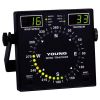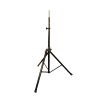YOUNG Serial Output Wind Monitors
Features
- Wind speed sensor is a four blade helicoid propeller that turns a multi-pole magnet
- Wind direction sensor is a durable molded vane
- Housing parts are UV-stabilized thermoplastic; fittings are stainless steel and anodized aluminum
- Free ground shipping
- Expedited repair and warranty service
- Lifetime technical support
- More
Overview
The RM Young 09101 Wind Monitor-SE offers maximum versatility in a conventional wind sensor. An optical encoder is utilized for vane angle measurement, thereby eliminating the characteristic deadband and wear of potentiometer transducers. The serial output signal is ideal for interfacing with modern data acquisition systems.
Wind Speed
The wind speed sensor is a four blade helicoid propeller that turns a multi-pole magnet. Propeller rotation induces a variable frequency signal in a stationary coil; movable slip rings and brushes are not used. The raw signal is converted to a digital serial output by the on-board microprocessor circuit. A more conventional voltage output may be selected simply by moving an internal jumper.
Wind Direction
The wind direction sensor is a durable molded vane. Vane angle is detected by a custom optical encoder. The encoder is an absolute type so direction output remains accurate even if power is interrupted. As with wind speed, a serial output or voltage output signal can be selected.
Durability
The RM Young 09101 Wind Monitor-SE is designed for superior environmental resistance. Housing parts are UV stabilized thermoplastic. Fittings are stainless steel and anodized aluminum. Precision-grade stainless steel ball bearings are used throughout. The instrument mounts on standard 1 inch pipe.
In The News
Village Green Project builds air quality awareness with monitoring park bench
The U.S. Environmental Protection Agency is on a mission to make air quality monitoring cheaper, easier and more accessible through the implementation of innovative new monitoring stations. The Village Green Project is a new initiative from the EPA that seeks to increase the scope of air quality monitoring by seamlessly incorporating monitoring devices into community settings. Led by Gayle Hagler, an environmental engineer at the EPA Office of Research and Development, an EPA design team has constructed a prototype that combines the ability to monitor ozone and fine particulate matter as well as wind speed, wind direction, temperature and humidity all into the functional design of a park bench.
Read MoreNASA develops ocean surface wind speed measurements through GPS
Researchers from the NASA Langley Research Center in Hampton, Va., have discovered that GPS signals can be used to accurately measure wind speed at the ocean’s surface, National Geographic has reported. Researchers have concluded that by measuring the distortion in GPS signals bouncing off the ocean’s waves, they can successfully measure wind speed, even in the case of hurricanes and extreme weather. To measure the accuracy of using GPS for wind measurements, NASA scientists placed GPS receivers on NOAA research planes. They concluded that GPS data has an accuracy capable of detecting wind speeds within 11 miles per hour.
Read MoreUNC's industry-standard water quality profiling platforms get upgrade
The University of North Carolina Institute Of Marine Sciences has a history with profiling platforms. UNC engineers and scientists have been building the research floaters for 10 years in a lab run by in Rick Luettich, director of the institute. UNC scientists and engineers developed their own autonomous vertical profilers to take water quality readings throughout the water column. They have three profilers placed in the New and Neuse rivers. The profilers are designed to drop a payload of sensors to an allotted depth at set time intervals. Instruments attached take readings continuously on the way down and up. Data collected by the profilers has been used to study water related issues such as infectious disease and sediment suspension.
Read More














